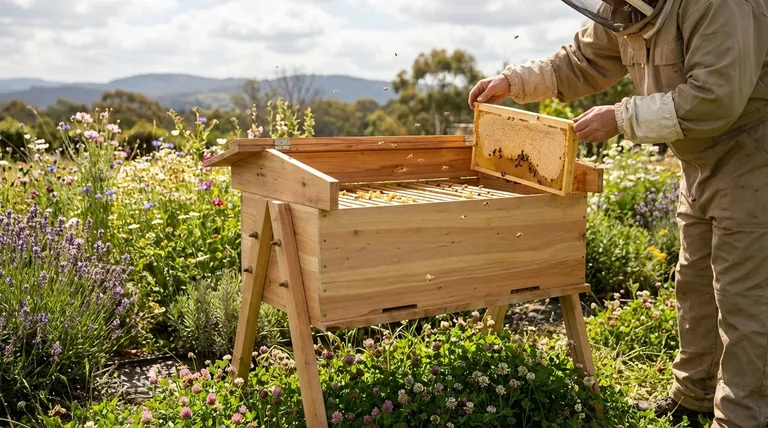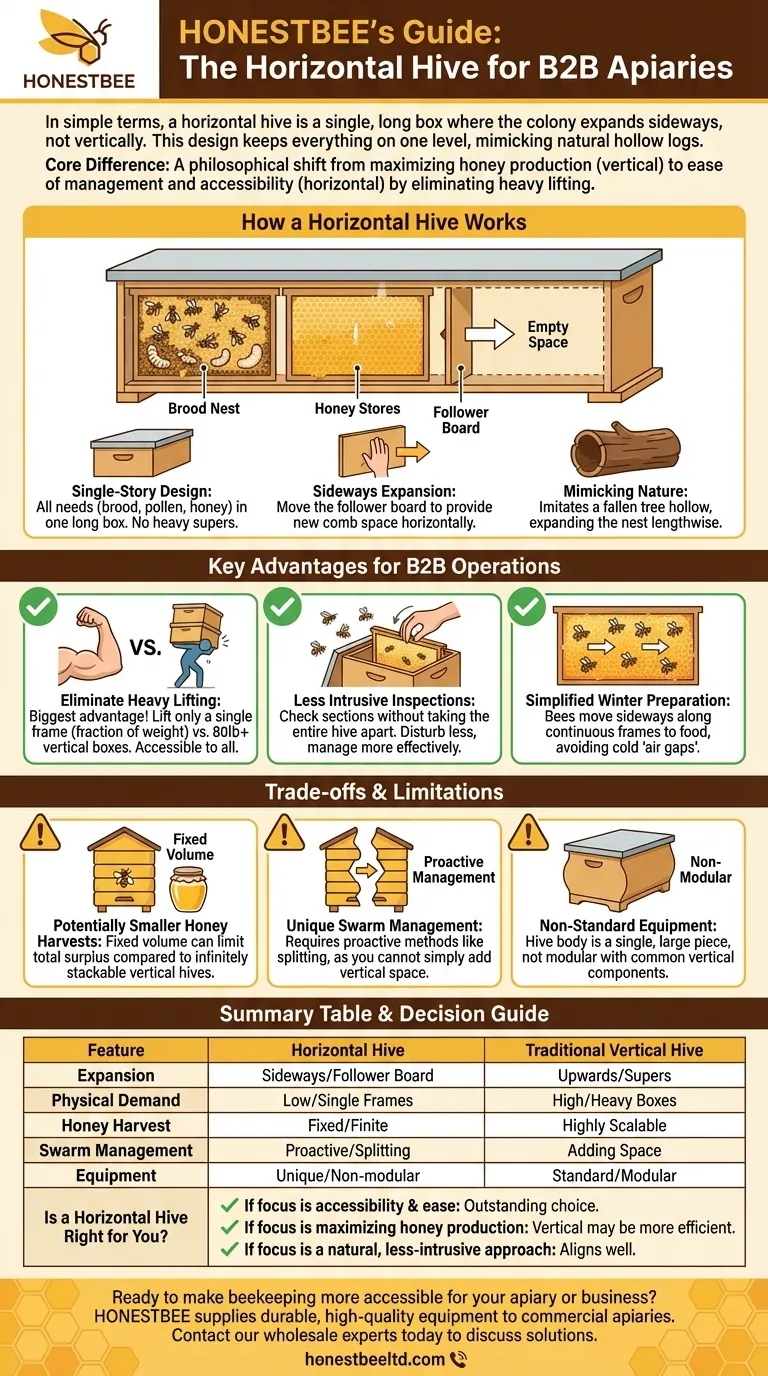In simple terms, a horizontal hive is a single, long beehive box where the colony expands sideways rather than vertically. Often called a "long hive," this design keeps the brood nest and honey stores all on the same level, mimicking how bees might naturally occupy a hollow log.
The core difference between a horizontal hive and a standard vertical hive is a philosophical one. Horizontal hives prioritize ease of management and accessibility by eliminating heavy lifting, while traditional vertical hives are designed to be expanded for maximum honey production.

How a Horizontal Hive Works
Unlike the familiar stack of boxes seen in most apiaries, a horizontal hive operates on a completely different spatial principle.
The Single-Story Design
Everything the colony needs—space for the queen to lay eggs (the brood nest), pollen stores, and honey reserves—is contained within one long box. There are no heavy upper boxes (supers) to add or remove.
Expanding the Colony Sideways
As the colony grows, the beekeeper provides more space by moving a divider, called a follower board, down the length of the hive. The bees then build new comb in the empty space, extending the nest horizontally.
Mimicking Nature's Design
This layout is thought to be more natural for the bees. In the wild, bees often inhabit fallen tree hollows, expanding their nest along the length of the cavity. A horizontal hive directly imitates this structure.
Key Advantages of Horizontal Beekeeping
Beekeepers choose this style for several distinct and practical reasons, most of which center on the physical demands of the hobby.
Eliminating Heavy Lifting
This is the most significant advantage. A standard deep hive box filled with honey can weigh over 80 pounds. In a horizontal hive, you only ever lift a single frame, which weighs a fraction of that. This makes beekeeping accessible to people with back problems, limited strength, or other physical constraints.
Less Intrusive Inspections
You can inspect the colony section by section without taking the entire hive apart. It is possible to check on the brood nest without disturbing the bees working in the honey storage area at the other end of the hive.
Simplified Winter Preparation
In a vertical hive, the colony cluster must move upward to reach honey stores, sometimes struggling to cross the cold "air gap" between boxes. In a horizontal hive, the bees simply move sideways along the continuous frames to access their winter food.
Understanding the Trade-offs and Limitations
While easier to manage physically, the horizontal design comes with its own set of challenges and is not the ideal choice for every goal.
Potentially Smaller Honey Harvests
A horizontal hive has a fixed, finite volume. While a vertical Langstroth hive can be stacked almost infinitely high to accommodate a massive nectar flow and population boom, a long hive can become "honey bound," limiting the total surplus honey you can harvest.
Unique Swarm Management
In a vertical hive, a beekeeper can often delay swarming by adding more boxes to relieve congestion. In a horizontal hive, preventing swarms requires more proactive management, such as splitting the colony, as you cannot simply add more vertical space.
Non-Standard Equipment
While many horizontal hives (like the Layens or Long Langstroth) use standard frame sizes, the hive body itself is a single, large piece of equipment. It is not modular or interchangeable with the common, widely available vertical hive components.
Is a Horizontal Hive Right for You?
Choosing a hive style depends entirely on your personal goals and physical capabilities as a beekeeper.
- If your primary focus is accessibility and physical ease: The horizontal hive is an outstanding choice that removes the biggest physical barrier in beekeeping—heavy lifting.
- If your primary focus is maximizing honey production for a business: A traditional vertical Langstroth hive is generally the more efficient and scalable system for commercial operations.
- If your primary focus is a natural, less-intrusive approach for a backyard hobby: The horizontal hive aligns well with this philosophy, offering a gentler way to interact with your colony.
Ultimately, the best beehive is the one that keeps you engaged and capable of providing excellent care for your bees.
Summary Table:
| Feature | Horizontal Hive | Traditional Vertical Hive |
|---|---|---|
| Hive Expansion | Sideways, using a follower board | Upwards, by adding boxes/supers |
| Physical Demand | Low; only lift individual frames | High; lift heavy, full boxes |
| Honey Harvest Potential | Fixed, finite volume | Highly scalable, larger potential |
| Swarm Management | Proactive (e.g., splitting) | Adding space can relieve congestion |
| Equipment | Unique, non-modular body | Standardized, widely available components |
Ready to make beekeeping more accessible for your apiary or business?
HONESTBEE supplies durable, high-quality beekeeping equipment to commercial apiaries and distributors. If the ergonomic benefits of a horizontal hive design align with your operational goals, our team can provide the supplies you need.
Contact our wholesale experts today to discuss equipment solutions for your beekeeping operation.
Visual Guide

Related Products
- Long Langstroth Style Horizontal Top Bar Hive for Wholesale
- HONESTBEE Professional Long Handled Hive Tool with Precision Cutting Blade
- HONESTBEE Professional Multi-Functional Hive Tool with Ergonomic Wood Handle
- HONESTBEE Advanced Ergonomic Stainless Steel Hive Tool for Beekeeping
- Top Bar Beehive for Beekeeping Wholesales Kenya Top Bar Hive
People Also Ask
- What are the main differences between Langstroth hives and top bar hives? Choose the Right Hive for Your Beekeeping Goals
- How does the design of a top bar hive benefit beekeepers? Ergonomic & Natural Beekeeping for Hobbyists
- How are entrances designed in top bar hives? Master Beehive Layout for Maximum Honey
- What is a top bar bee hive? A Natural, Low-Stress Beekeeping Solution
- What are the advantages of a top bar hive? Simpler, Bee-Centric Beekeeping for All



















